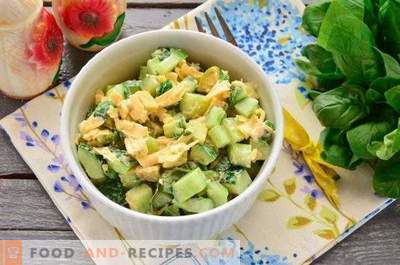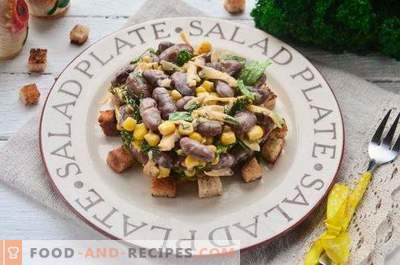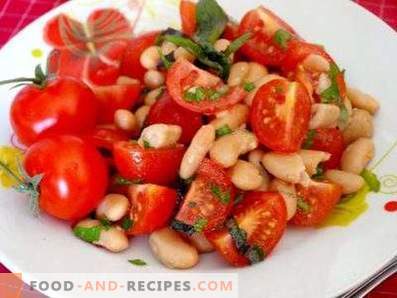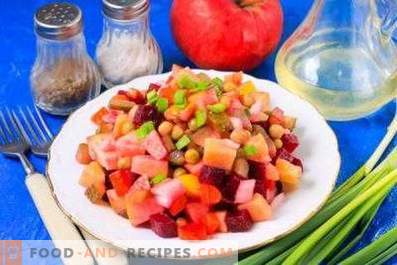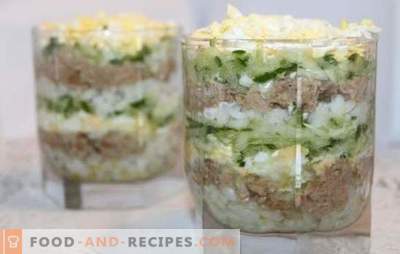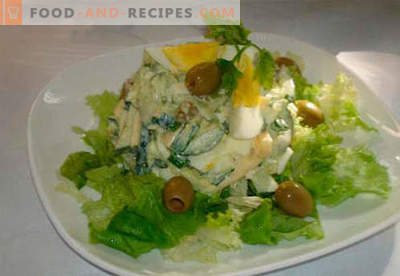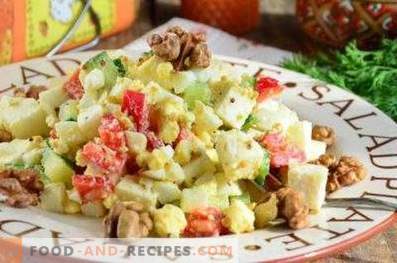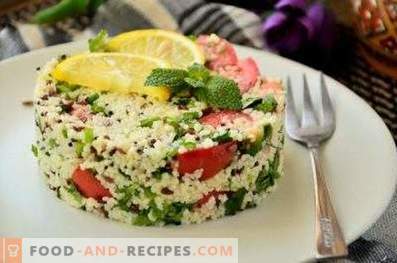
Tabbouleh - a popular dish of Arabic cuisine, which can be attributed to the category of salads. This oriental snack turns out fresh, light, but well nourishes. It is based on one of the varieties of wheat cereal (most often bulgur) and fresh greens (mainly parsley and mint). Often consists of fresh vegetables. Salad is seasoned with a mixture of lemon juice and oil. Tabule can be called a dietary dish, this salad arouses interest among supporters of healthy food and vegetarians, but few people know how to cook it.
Cooking Features
Even an inexperienced chef can cope with cooking a taboo, and it will take a little time. However, an aspiring hostess, unfamiliar with the technology of cooking this dish, will almost certainly have some difficulty, not knowing what to do with the products that make up the snack. Secrets of experienced chefs will allow you to feel confident in your abilities and do everything right.
- Most often, the tabula contains bulgur or couscous, popular in many eastern countries. Both products are made from wheat, but according to different technologies. For the production of bulgur millet is treated with boiling water and finely crushed. Couscous is made from semolina, sprinkling it with water and treating with flour or dry semolina, because of which it takes the form of small pellets. The cooking technology of these cereals is about the same: they are poured with boiling water and infused for 5 minutes, then loosened with a spoon or fork. Flush these cereals should not be. If bulgur is not small enough, it may need to be boiled. In this case, the cereal is first fried in oil, then poured with water at a ratio of 1: 2 and boiled until the cereal absorbs all the liquid. The technology of cooking Bulgur and couscous is usually described on the package. In some countries, larger varieties of wheat cereals are used. For example, in Armenia, a tabula is made from barley. To make it well boiled soft, it should be pre-soaked.
- The main ingredient in the tabula is fresh greens. It should not be cut too small, using a sharp knife, so that the juice does not remain on the cutting board, but rather soaks the cereal. Most of the greens use parsley. Be sure to put in a salad a small amount of fresh mint.
- Before you put the cereal in a salad, you need to cool it down, otherwise the appetizer will be less tasty and quickly spoiled.
The classic taboo recipe, which is used in almost all Arab countries, is extremely simple: it contains nothing but cereals, greens and onions. However, the recipe is often supplemented with fresh vegetables. The most famous and popular in our country are the Lebanese and Armenian versions of this dish.
Classic taboo recipe
Composition:
- Bulgur - 50 g;
- fresh parsley - 0, 2 kg;
- onions - 50 g;
- lemon - 1 pc .;
- fresh mint - 20 g;
- vegetable oil - 40 ml;
- salt - to taste.
Method of preparation:
- Bulgur pour boiling water over it, cover with a lid. After 5-10 minutes, loosen the fork. Wait for it to cool. If you have a type of bulgur that requires cooking, prepare the grits according to the instructions on the package and cool them as well.
- Peel onions, cut into thin rings. It will look good in a red onion salad.
- Wash and shake mint and parsley from the water. Drain the greens with napkins.
- Mint sprig set aside to decorate the snack, finely chop the rest with a sharp knife.
- Cut the parsley, but not too small.
- Put bulgur, parsley and mint in a bowl. Stir.
- In a separate container, mix squeezed lemon juice and vegetable oil. Salt the dressing. You can add some oriental spices.
- Pour the resulting sauce over the food, stir it again.
- Put the salad in a salad bowl or on a plate. Put onion rings on it. Put a sprig of mint on top.
Bulgur in this recipe can be replaced with couscous. Onions can be cut into smaller pieces and mixed with the rest of the ingredients before dressing the salad dressing. Sometimes sweet pepper is added to the recipe. In this case, you need to take it in moderate quantities: 50 g of pepper, cut into small straws or small squares, is enough for the amount of ingredients indicated in the recipe.
Taboula in Lebanese
Composition:
- Bulgur or couscous - 70 g;
- fresh parsley - 0, 2 kg;
- green onions - 100 g;
- onions - 30 g;
- mint leaves - 6-7 pcs .;
- tomatoes - 0, 25 kg;
- lemon juice - 20 ml;
- olive oil - 40 ml;
- salt, paprika - to taste.
Method of preparation:
- Bulgur or couscous brew with boiling water. When the cereal is completely absorbed water, loosen it, leave to cool.
- Onions, freed from the husk, cut into small pieces, put in a bowl.
- Wash, dab dry green onions, parsley and mint. Chop them with a sharp knife as small as possible. Put to the onions.
- Boil in tomatoes, remove the skin from them. Cut the seal around the stem. Cut the tomato pulp into small cubes, send to the greens.
- Transfer the cooled cereal to the bowl with the rest of the food.
- Mix the butter, lemon juice, salt and paprika separately. Season the salad with this mixture.
It is advisable to submit grape or salad leaves to the tabula; in Lebanon, snack is eaten with their help. Instead of bread, it is appropriate to offer pita bread.
Taboula in Armenian
Composition:
- pearl barley - 150 g;
- dried tomatoes - 20 g;
- pitted olives - 20 g;
- pine nuts - 20 g;
- fresh cucumber - 150 g;
- canned corn - 130 g;
- fresh parsley - 100 g;
- mint - 40 g;
- basil - 40 g;
- olive oil - 40 ml;
- lemon juice - 20 ml;
- goat cheese - 100 g.
Method of preparation:
- Pick and wash the pearl barley, add water for 2 hours, then wash again. Fill with clean water and boil until tender. Throw in a colander, rinse again. Let the water flow and cool the croup to dry.
- Wash, shake off the greens. When it dries, finely chop it with a knife, put it in a bowl.
- Toast the pine nuts in a dry frying pan, send to the greens.
- Cut the tomatoes and olives into small pieces, send them to the remaining ingredients.
- Wash cucumber, blotted with a napkin. Cut off the tips. Cut the vegetable into small cubes. Put in a bowl for the rest of the products.
- Add chilled barley to ground products.
- Pour the corn. This ingredient is not required in the salad, but gives it a special taste.
- Season the salad with a mixture of lemon juice and olive oil.
- Put the salad on a plate or salad bowl.
- Crumble up the cheese, sprinkle on the salad.
This taboo version is significantly different from the classic one. The recipe clearly shows the influence of European culinary traditions. However, the taste of the snacks cooked on it still has notes typical for an Arab snack.
How to decorate tabula
Due to the large amount of fresh herbs that make up the dish, the tabule looks bright and fresh, even if you don’t try to decorate it aesthetically. However, it is possible to serve a snack more beautifully.
- In the East, lettuce or Chinese cabbage is often used to decorate tabula. They can lay on the dish, and already put them on the salad. Often the leaves are simply laid out around the snack or even stuck into it.
- An even more fresh type of snack is lemons and mint. Lemon slices are placed on the edge of the plate, and a mint sprig is put on top of the salad, which is laid on a hill.
- Bright notes of lettuce will give tomatoes. Cherry tomatoes can be expanded around the perimeter, pre-cut them in half. Large tomatoes are cut into 2 parts, extract the seeds with a piece of pulp, fill the space inside the vegetables filled with lettuce.
The tabula looks beautiful on the plates decorated in the Arabic style.
Tabule is a light and at the same time hearty Arabic salad. The eastern flavor is given to it by bulgur or couscous, an abundance of greenery. Snacks will appeal to those who care about their health. Especially nice to have it in the summer. Tabule is suitable for vegetarian food, can be used in fasting. If the recipe has cheese, you can replace it with tofu.
